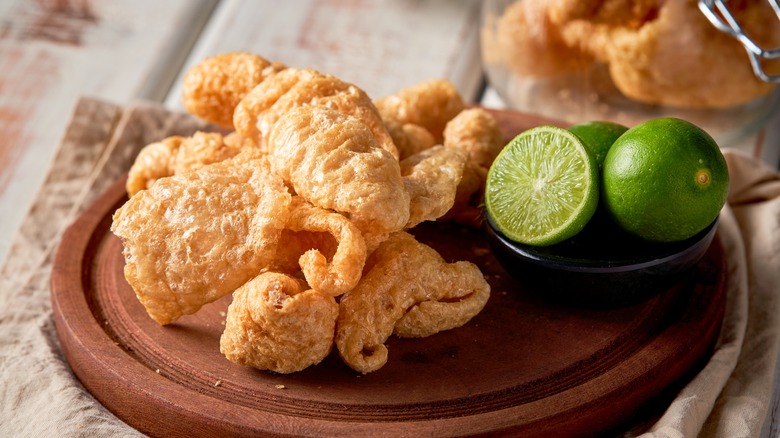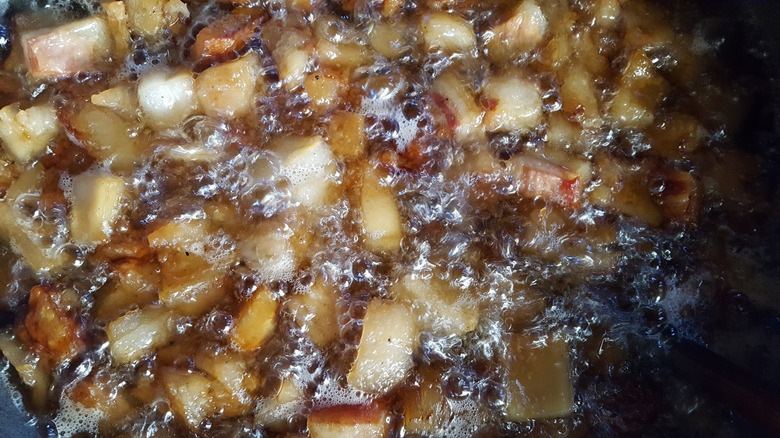Boiling Is The Key To Light And Crispy Pork Rinds
Crispy pork rinds appear in cuisines all across the world. There are British pork scratchings, chicharrones in Spain and Latin America, and Cajun cracklins, to name a few. It's worth noting that not all crispy pork skin products are the same. Some of these savory delights will be made from pork skin pieces with some fat and sometimes also meat still attached, whereas others are made from pork skin with all the fat removed. With the fat and meat attached, there's more moisture in the pieces of pork and the result is deep golden brown nuggets of delicious crispy pork.
Pork rinds, on the other hand, are made from pieces of pork skin without any fat or meat at all. Pork rinds are unbeatably crispy, but only if you boil them first. They're also light and pale: Pleasing little clouds of crunchy goodness.
Much of the secret behind good homemade pork rinds lies in the boiling — this process releases the collagen from the skin, which softens it and results in that yielding crunch you're looking for once they've been fried. You can also rub baking soda into the skin before boiling, which aids the crisping process even more.
How to make perfectly crispy pork rinds
If your pork skin still has fat and meat attached, you're going to end up with a substantial snack that lacks the signature light, airy crunch of a perfect pork rind. So before boiling the skin, make sure to remove most of the fat and chop it into bitesize pieces, keeping in mind that once dehydrated and then fried (make sure to pick the perfect oil) they'll enlarge up to four or five times their size.
Now it's time to boil the skin. Do this for at least 30 minutes, by which time the pieces should have visibly softened and any remaining fat attached to the skin will have rendered down slightly. Remove them from the water, and once they've cooled off it'll now be much easier to scrape or slice all the remaining fat from the skin. This is the secret for making homemade pork rinds with that perfect combo of light and crispy. Boiling ensures that instead of tough and chewy, you get crispy, crunchy pork rinds each and every time. Once boiled, you can continue on in the cooking process.
Homemade pork rinds can take your cooking to the next level
Pork rinds are fantastically suited to being a bar-style snack. Their crunch and mild savory pork fat flavor work wonders when paired with a beer after a hard day's work. You'll find their British cousin, the pork scratching, for sale behind the bar of practically every pub in the U.K. for this precise reason.
What's the best way to serve them? You can add a little extra flavor by tossing them in a little salt and smoked paprika when they're fresh out of the oil. David Chang's chicharron recipe combines salt and togarashi to sprinkle on top. Or, get creative and add your own spices and seasonings to them. Because it's such a prevalent food in many different cuisines, the sky's the limit in terms of the seasonings or condiments you can add to your homemade pork rinds once they're fried!
However, where crispy pork rinds really come into their own is as a garnish for other dishes. They're a great pork taco topping, but because their flavor isn't intensely 'pork-ey', they also work well as an addition to non-pork dishes for adding crunch and class; think of them as little pieces of pork popcorn. For example, why not use them to add contrasting texture to a typically soft dish like beef tartare or as an added crunch on top of a salad? Now that you know how to boil your pork rinds, the sky's the limit to how you can enjoy them.


